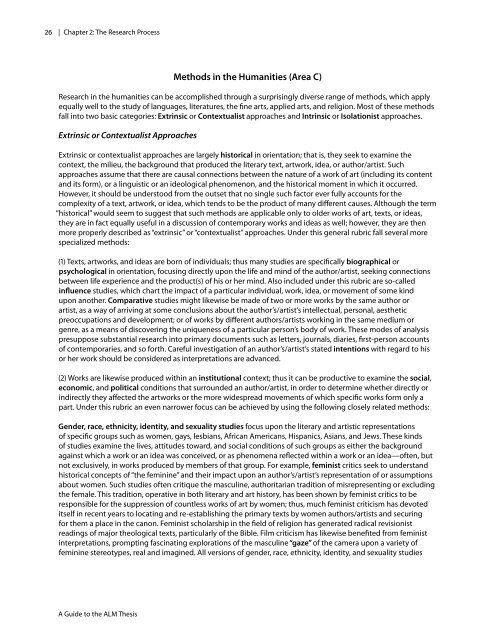A Guide to the ALM Thesis - iSites - Harvard University
A Guide to the ALM Thesis - iSites - Harvard University
A Guide to the ALM Thesis - iSites - Harvard University
Create successful ePaper yourself
Turn your PDF publications into a flip-book with our unique Google optimized e-Paper software.
26<br />
| Chapter 2: The Research Process<br />
Methods in <strong>the</strong> Humanities (Area C)<br />
Research in <strong>the</strong> humanities can be accomplished through a surprisingly diverse range of methods, which apply<br />
equally well <strong>to</strong> <strong>the</strong> study of languages, literatures, <strong>the</strong> fine arts, applied arts, and religion. Most of <strong>the</strong>se methods<br />
fall in<strong>to</strong> two basic categories: Extrinsic or Contextualist approaches and Intrinsic or Isolationist approaches.<br />
Extrinsic or Contextualist Approaches<br />
Extrinsic or contextualist approaches are largely his<strong>to</strong>rical in orientation; that is, <strong>the</strong>y seek <strong>to</strong> examine <strong>the</strong><br />
context, <strong>the</strong> milieu, <strong>the</strong> background that produced <strong>the</strong> literary text, artwork, idea, or author/artist. Such<br />
approaches assume that <strong>the</strong>re are causal connections between <strong>the</strong> nature of a work of art (including its content<br />
and its form), or a linguistic or an ideological phenomenon, and <strong>the</strong> his<strong>to</strong>rical moment in which it occurred.<br />
However, it should be unders<strong>to</strong>od from <strong>the</strong> outset that no single such fac<strong>to</strong>r ever fully accounts for <strong>the</strong><br />
complexity of a text, artwork, or idea, which tends <strong>to</strong> be <strong>the</strong> product of many different causes. Although <strong>the</strong> term<br />
“his<strong>to</strong>rical” would seem <strong>to</strong> suggest that such methods are applicable only <strong>to</strong> older works of art, texts, or ideas,<br />
<strong>the</strong>y are in fact equally useful in a discussion of contemporary works and ideas as well; however, <strong>the</strong>y are <strong>the</strong>n<br />
more properly described as “extrinsic” or “contextualist” approaches. Under this general rubric fall several more<br />
specialized methods:<br />
(1) Texts, artworks, and ideas are born of individuals; thus many studies are specifically biographical or<br />
psychological in orientation, focusing directly upon <strong>the</strong> life and mind of <strong>the</strong> author/artist, seeking connections<br />
between life experience and <strong>the</strong> product(s) of his or her mind. Also included under this rubric are so-called<br />
influence studies, which chart <strong>the</strong> impact of a particular individual, work, idea, or movement of some kind<br />
upon ano<strong>the</strong>r. Comparative studies might likewise be made of two or more works by <strong>the</strong> same author or<br />
artist, as a way of arriving at some conclusions about <strong>the</strong> author’s/artist’s intellectual, personal, aes<strong>the</strong>tic<br />
preoccupations and development; or of works by different authors/artists working in <strong>the</strong> same medium or<br />
genre, as a means of discovering <strong>the</strong> uniqueness of a particular person’s body of work. These modes of analysis<br />
presuppose substantial research in<strong>to</strong> primary documents such as letters, journals, diaries, first-person accounts<br />
of contemporaries, and so forth. Careful investigation of an author’s/artist’s stated intentions with regard <strong>to</strong> his<br />
or her work should be considered as interpretations are advanced.<br />
(2) Works are likewise produced within an institutional context; thus it can be productive <strong>to</strong> examine <strong>the</strong> social,<br />
economic, and political conditions that surrounded an author/artist, in order <strong>to</strong> determine whe<strong>the</strong>r directly or<br />
indirectly <strong>the</strong>y affected <strong>the</strong> artworks or <strong>the</strong> more widespread movements of which specific works form only a<br />
part. Under this rubric an even narrower focus can be achieved by using <strong>the</strong> following closely related methods:<br />
Gender, race, ethnicity, identity, and sexuality studies focus upon <strong>the</strong> literary and artistic representations<br />
of specific groups such as women, gays, lesbians, African Americans, Hispanics, Asians, and Jews. These kinds<br />
of studies examine <strong>the</strong> lives, attitudes <strong>to</strong>ward, and social conditions of such groups as ei<strong>the</strong>r <strong>the</strong> background<br />
against which a work or an idea was conceived, or as phenomena reflected within a work or an idea—often, but<br />
not exclusively, in works produced by members of that group. For example, feminist critics seek <strong>to</strong> understand<br />
his<strong>to</strong>rical concepts of “<strong>the</strong> feminine” and <strong>the</strong>ir impact upon an author’s/artist’s representation of or assumptions<br />
about women. Such studies often critique <strong>the</strong> masculine, authoritarian tradition of misrepresenting or excluding<br />
<strong>the</strong> female. This tradition, operative in both literary and art his<strong>to</strong>ry, has been shown by feminist critics <strong>to</strong> be<br />
responsible for <strong>the</strong> suppression of countless works of art by women; thus, much feminist criticism has devoted<br />
itself in recent years <strong>to</strong> locating and re-establishing <strong>the</strong> primary texts by women authors/artists and securing<br />
for <strong>the</strong>m a place in <strong>the</strong> canon. Feminist scholarship in <strong>the</strong> field of religion has generated radical revisionist<br />
readings of major <strong>the</strong>ological texts, particularly of <strong>the</strong> Bible. Film criticism has likewise benefited from feminist<br />
interpretations, prompting fascinating explorations of <strong>the</strong> masculine “gaze” of <strong>the</strong> camera upon a variety of<br />
feminine stereotypes, real and imagined. All versions of gender, race, ethnicity, identity, and sexuality studies<br />
A <strong>Guide</strong> <strong>to</strong> <strong>the</strong> <strong>ALM</strong> <strong>Thesis</strong>

















